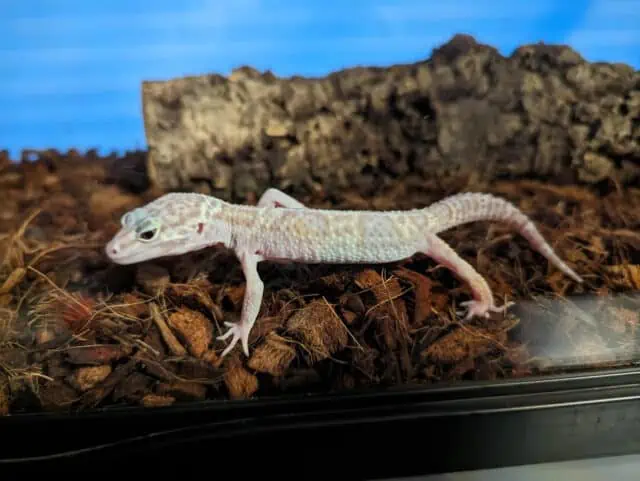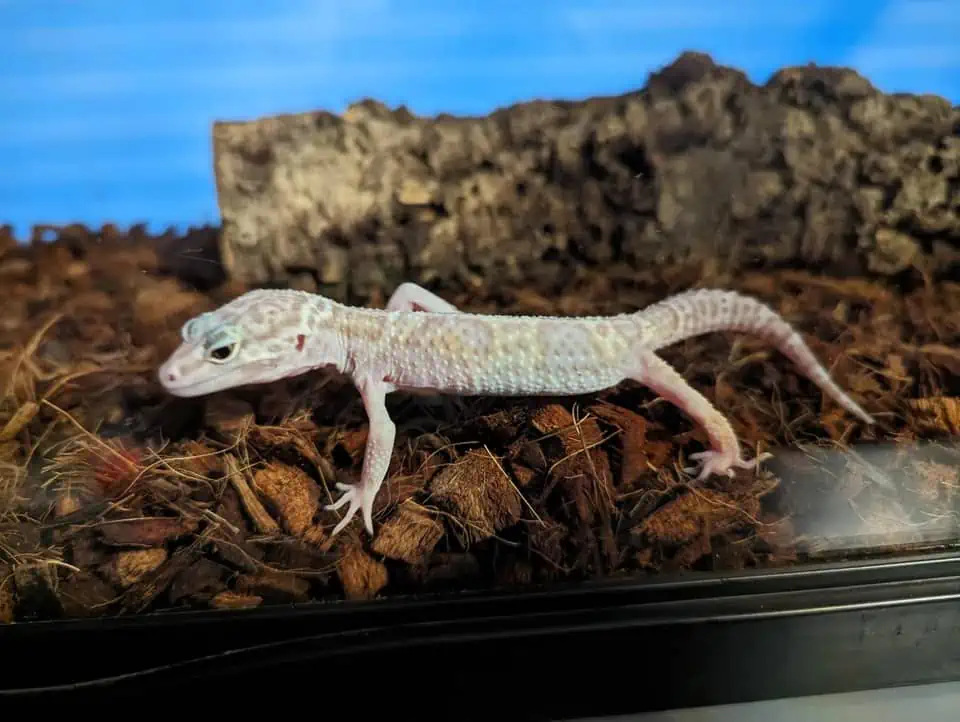If your leopard gecko appears underweight, it’s crucial to address the issue immediately. Ensuring a varied and nutritious diet, optimizing their environment, and reducing stress are key factors in helping your gecko gain weight.
Proper feeding frequency and recognizing the signs of an underweight gecko can aid in monitoring their health and making necessary adjustments. Knowing the underlying causes, from dietary insufficiencies to age-related issues, helps in providing targeted care.
How to Help An Underweight Leopard Gecko

Helping an underweight leopard gecko requires a multifaceted approach. Addressing diet, environment, and stress are essential steps.
Give Him a Varied Diet
A balanced diet is fundamental for the health of your leopard gecko. One of the primary ways to ensure this balance is by feeding them a variety of staple insects. Some of the most beneficial insects for a leopard gecko’s diet include crickets, mealworms, silkworms, and hornworms. Each of these insects offers distinct nutrients vital for your gecko’s well-being.
Moreover, it’s not just about feeding these insects. The practice of gut loading—feeding the insects a nutrient-rich diet before they’re given to the gecko—can significantly boost the nutritional value of the gecko’s meal.
In addition, incorporating the right supplements into their diet is essential. These supplements help fill any nutritional gaps and ensure your leopard gecko receives all the necessary vitamins and minerals.
Fatty Insects Should Be Included
For an underweight leopard gecko, fatty insects play a pivotal role in helping them regain a healthy weight. These insects are dense in calories and can provide the energy boost your gecko needs. While it’s essential to include them in the diet, it’s equally crucial to choose the right ones.
Some insects might boast a high fat content, but they don’t necessarily offer substantial nutritional value. As a result, such insects should be given sparingly, treating them more as treats or occasional supplements rather than main diet staples.
Among the best fatty insects to consider for your gecko’s diet are superworms, waxworms, and butterworms. Each of these has been proven beneficial for geckos needing to put on some weight. Once they’ve reached the right weight, be sure to stop giving them fatty insects in larger quantities, so they don’t become fat themselves.
However, it’s vital to be cautious about the insects you choose. An expert tip to remember is to avoid feeding your gecko any insects that glow. Such luminescent insects might contain toxins that can be harmful to your pet.
Adding Nutritional Value
The overall health and well-being of a leopard gecko significantly rely on the nutritional value of its diet. To ensure your gecko receives all the essential nutrients, incorporating supplements and the practice of gut loading is paramount. Supplements, especially calcium and vitamins, play a crucial role in bone health and overall vitality. However, it’s not just about adding these supplements; it’s about doing it right.
Dusting the gecko’s food with these nutrients is a common method, but one needs to adhere to a proper dusting schedule. Over-supplementing can lead to other health issues, so maintaining a balance is key.
Now, while supplements are vital, they work best in conjunction with gut loading. Gut loading is a technique where you feed the insects a high-nutrient diet before offering them to the gecko.
When these nutrient-rich insects are consumed, they pass on the enhanced nutritional benefits to the gecko. This two-pronged approach of supplements and gut loading ensures that the leopard gecko diet is optimal, promoting health and longevity.
Eliminate Stress
Stress can be detrimental to a leopard gecko’s health, especially if it’s already underweight. Identifying and addressing potential stressors is essential for the well-being of your pet. Some common stressors include sudden changes in their environment, presence of predators, or even inadequate hiding spots in their habitat.
Handling frequency is another significant stressor. While bonding with your gecko is essential, it’s crucial to do it gradually. During the first 3-5 months of its life, it’s best to limit handling. Initially, you might want to limit it to 2-3 times a week.
As your gecko gets more accustomed to you, and bonding progresses, you can reduce this frequency to 1-2 times a week. This gradual approach ensures the gecko doesn’t feel threatened, helping in establishing trust.
Furthermore, while hand feeding can be an intimate bonding activity, it’s advisable to limit it to once a week. Overdoing it can become another source of stress.
Check The Environment
The environment plays a pivotal role in the health of a leopard gecko. When addressing the issue of an underweight leopard gecko, checking and optimizing their environment becomes even more critical. Several factors need consideration to ensure the habitat is conducive to the gecko’s well-being.
One of the most vital environmental factors is the proper temperature range. Leopard geckos are ectothermic, meaning their body temperature is influenced by their surroundings. Maintaining a temperature between 90° to 93° degrees Fahrenheit (32° – 34° C) on the hot side ensures they can digest food efficiently. On the cooler side, a temperature around 74° degrees Fahrenheit (23° C) is optimal. This temperature gradient allows the gecko to regulate its body temperature, ensuring good digestion and appetite.
To accurately monitor and maintain these temperatures, using a digital thermometer is highly recommended. These devices provide precise readings, enabling you to adjust the environment as needed.
How Often Should You Feed It
Feeding frequency plays a significant role in the health and weight of a leopard gecko. For an underweight leopard gecko, it’s essential to provide regular meals that are both nutritious and in appropriate quantities. Regular and consistent feeding helps the gecko gain weight and attain a healthy stature.
For juvenile leopard geckos, their rapid growth demands more frequent feeding. It’s advisable to feed them daily, ensuring they receive a diverse range of insects to meet their nutritional needs.
As they grow and transition into adulthood, their metabolic rate slows down a bit. Adult leopard geckos should be fed every other day. Regardless of age, ensuring they receive a variety of insects, both staple and fatty, is crucial to provide a balanced diet.
Signs of an Underweight Leopard Gecko
Recognizing the signs of an underweight leopard gecko is paramount for timely intervention and care. Physical appearance and behavioral changes can offer insights into their health status.
Physical Signs
Physical manifestations are often the most noticeable indicators of an underweight leopard gecko. One of the most prominent signs is the “stick tail,” where the tail, usually a storage place for fats, appears thin and bony.
Additionally, sunken eyes can indicate dehydration or malnutrition, giving the gecko a gaunt look. Another alarming sign is a visible spine and prominent hip bones, which are typically covered by healthy flesh in well-fed geckos.
Furthermore, the skin may appear wrinkled and loose, lacking the tautness seen in healthy geckos. Health issues could even make some female leopard geckos to lay eggs which are infertile.
Behavioral Changes
In addition to physical signs, behavioral changes can also hint at the health status of a leopard gecko. Appetite loss is a significant red flag; if a gecko is not interested in its meals or eats less than usual, it might be underweight or heading in that direction. Another concerning behavior is lethargy.
A healthy gecko is active, especially during its typical active hours, but an undernourished one might appear sluggish or uninterested in its surroundings. Furthermore, aggression, which is uncharacteristic of leopard geckos, can emerge when they are stressed due to health issues.
Causes of Underweight in Leopard Geckos
Understanding the root causes of an underweight condition in leopard geckos is essential for effective intervention. Various factors, ranging from dietary issues to environmental stressors and age-related concerns, can influence a gecko’s weight.
Poor Diet
A poor diet is one of the primary reasons leopard geckos may become underweight. Several factors can contribute to this, with a lack of variety in insects being at the forefront.
Relying on just one or two types of insects can deprive the gecko of essential nutrients. Additionally, inadequate gut loading means the insects themselves aren’t nutritionally rich when fed to the gecko.
The importance of proper supplementation cannot be overstated; without it, geckos can miss out on vital vitamins and minerals. Improper feeding frequencies, such as feeding too infrequently or not providing enough food, can also lead to weight loss.
Stress and Illness
The interplay between stress and illness can have profound effects on a leopard gecko’s weight. Stress, whether from environmental factors or handling, can lead to reduced appetite and digestive issues, subsequently causing weight loss. Moreover, stressed geckos are more susceptible to various illnesses, further exacerbating their underweight condition. They could even lose their tail, though it will regrow back.
Several diseases are commonly associated with weight loss in leopard geckos. Metabolic bone disease, resulting from calcium deficiency, can lead to weakened bones and an overall frail appearance.
Respiratory illness, often characterized by labored breathing or mucus around the nostrils, can also contribute to weight loss as it affects the gecko’s appetite and energy levels.
Symptoms such as lethargy, lack of appetite, visible bone deformities, or breathing difficulties are clear indicators of potential health issues. If a leopard gecko displays any of these symptoms, it’s imperative to seek veterinary care promptly.
Age-Related Issues
Age plays a significant role in the health and weight of leopard geckos. As with many animals, age-related weight loss is not uncommon in these reptiles.
Older geckos often experience a slowdown in metabolism, meaning they burn fewer calories and might not eat as much as they used to. This reduced metabolic rate can lead to gradual weight loss over time.
Additionally, reproductive stress in adult females can contribute to weight loss. Laying eggs demands a lot of energy and nutrients, and if not compensated with adequate nutrition, females can become underweight. It’s essential to monitor the diet of breeding females closely to ensure they’re getting all the nutrients they need.
Furthermore, age-related health issues can directly impact a gecko’s appetite and digestion. Older geckos might face challenges in digesting certain foods, or they might develop conditions that affect their appetite.





